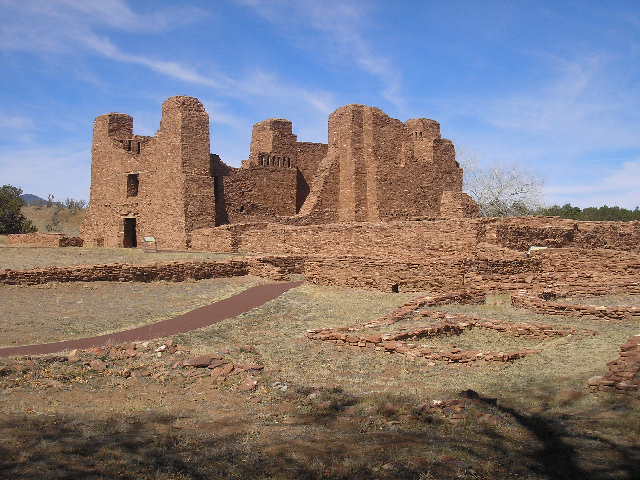This is a story about a fantastic place that few travelers find, a place once alive with intense human efforts and then abruptly left to the grass, trees, and brush. It’s a story of an American native society-I would call it “civilized”—that flourished and then disappeared. Jared Diamond* described societies that grew and collapsed due to vain consumption of their ecology. In contrast, I suggest that the little-known society of the Salinas Valley in New Mexico collapsed due to a forced adoption of someone else’s vanity. There’s both beauty and a lesson in the story.

The area that is now New Mexico was occupied by the Spanish well before Jamestown was founded (1607). At that time, the approximately 10,000 native pueblo people of the Salinas Valley were trading goods with other natives. The Franciscans came as missionaries to convert the Indians to Catholicism. However, the Spanish also brought both the inquisition and enslavement, using the natives and to construct huge churches and to ship salt to Mexico. Salinas means salt pans; the salt was used in refining silver. The ruins of three magnificent churches remain at separate locations.
Wikipedia condenses the history. “Once, thriving Native American trade communities of Tiwa and Tompiro-language-speaking Puebloans inhabited this remote frontier area of central New Mexico. Early in the 17th century Spanish Franciscans found the area ripe for their missionary efforts. However, by the late 1670s the entire Salinas District, as the Spanish had named it, was depopulated of both Indian and Spaniard. What remains today are austere yet beautiful reminders of this earliest contact between Pueblo Indians and Spanish Colonials: the ruins of three mission churches, at Quarai, Abó, and Gran Quivira and the partially excavated pueblo of Las Humanas or, as it is known today, the Gran Quivira pueblo.“
The Salinas Pueblo Missions National Park now offers the ruined cathedrals for your visitation. The brochures celebrate the beautiful architecture of the “missions” on the open landscape. Other literature infers a story of oppression.
“…for three years no Crops have been harvested. Last year a great many Christian Indians starved, left dead along the roads, in the ravines, and in their huts. There were towns like Las Humanas where more than 450 starved. Now the same Calamity still prevails, for in the whole kingdom there is not a bushel basket of corn, nor of wheat to be had at any price …” (Friar Juan Bernal, April 1, 1669)
Friar Bernal also said, “…heathen Apaches … kill all the Christian Indians they can find … no road is safe …” The friar apparently apparently didn’t report that the Spanish, unable to conquer the Apaches, instead bribed them to aid in controlling the “Christian” people of the pueblos.
And why is the Salinas story relevant? Because, like the Franciscans saving native souls from Hell, we are tempted to save a large population attempting to escape from the miseries induced by its current culture south of the border. However, I encourage us to examine our own limitations and the potential outcomes of the salvation process.
—-
- * Jared Diamond Collapse. Viking Penguin, 2005.
- If the text appears fragmented or the photo is not clear in your email, click here to see the story as posted. WordPress introduced a new digital editor, and strange things happened in the email version of Blog 141.